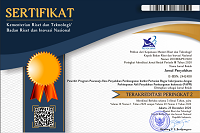Perilaku Petani dalam Menerapkan Teknologi BP3T (Bakteri Perakaran Pemacu Pertumbuhan Tanaman) Pupuk Kandang untuk Tanaman Kakao di Kabupaten Limapuluh Kota
Abstract
Vascular streak dieback (VSD) is a deadly disease of cocoa because it attacks the vascular tissue growing point. RGBGP Technology (Root Growth Based Growth Plants) manure is designed to help control the disease while helping grow cocoa plants. This research aims to examine the behavior of cocoa farmers in applying RGBGP technology package of manure that is allegedly formed due to individual characteristics and innovation characteristics. This research was designed descriptively qualitative located in Limapuluh Kota District. Sampling was conducted by census, 43 people belonging to 4 selected farmer groups, namely Aroma, Inovasi, Buah Lobek, and Maju Sejahtera. The results show that farmers' behavior generally shows the willingness to implement RGBGP package of manure in the long term, supported by the relative advantages of innovation, accessible resources, easy to do and applied technology, observable results, and no significant constraints. However, attitudes are not related to individual characteristics of farmers consisting of formal education, nonformal education, experience of farming, land status, land area, main occupation, and gender.
Downloads
References
Ajak, J. D. A.,dan Demiruyek, K. 2017. Agricultural Innovation System: Case of Cassava Producers in Kajo-Keji, South Sudan. American Journal of Agriculture and Forestry. 5(4): 94-101.
Anggreany, S., Muljono, P., dan Sadono, D. 2016. Partisipasi Petani dalam Replanting Kelapa Sawit di Provinsi Jambi. Jurnal Penyuluhan. 12(1): 1-14.
Azwar. 2000. Sikap Manusia, teori dan Pengukurannya. Pustaka Pelajar Offset. Yogyakarta.
Edwina, S., dan Maharani, T. 2010. Persepsi Petani terhadap Inovasi Teknologi Pengolahan Pakan Ternak di Kecamatan Kerinci Kanan Kabupaten Siak. Indonesian Journal of Agriculture Economis. 2, 170-183
Fachrista, I. A., dan Sarwendah, M. 2014. Persepsi dan Tingkat Adopsi Petani Terhadap Inovasi Teknologi Pengelolaan Tanaman Terpadu Padi Sawah. Agriekonomika. 3(1): 1-10.
Farid, A., Romadi, U., dan Witono, D. 2018. Faktor-Faktor yang Mempengaruhi Adopsi Petani dalam Penerapan Sistem Tanam Jajar Legowo di Desa Sukosari Kecamatan Kasembon Kabupaten Malang Provinsi Jawa Timur. Jurnal Penyuluhan. 14(1): 27-32.
Ilori, A. B., Lawal A. F., dan Oke S. 2017. Effect of Socio-Economics Characteristics, Production and Innovation Capabilities on the Performance of Palm Kernel Processing Firms in South-western Nigeria. IJERMT. 6(1): 88-95.
Lalla, H., Ali, M. S. S., dan Saadah. 2012. Adopsi Petani Padi Sawah Terhadap Sistem Tanam Jajar Legowo 2:1 di Kecamatan Polongbangkeng Utara, Kabupaten Takalar.J Sains & Teknologi. 12(3): 225-264.
Malta. 2016. Faktor-faktor yang Berhubungan dengan Kemandirian Petani dalam Pengambilan Keputusan untuk Keberlanjutan Usahatani (Kasus: Petani di Desa Sukaharja - Kabupaten Bogor).Sosiohumaniora.18(2): 118-124.
Manyamsari, I., Mujiburrahmad. 2014. Karakteristik Petani Dan Hubungannya Dengan Kompetensi Petani Lahan Sempit (Kasus : Di Desa Sinar Sari Kecamatan Dramaga Kab. Bogor Jawa Barat). Agrisep. 15(2): 58-74.
Mariana M dan Noveriza R. 2013. Potensi minyak atsiri untuk mengendalikan Potyvirus pada Tanaman Nilam. Jurnal Fitopatologi Indonesia. 9(1):53-58. DOI: 10.14692/jfi.9.2.53
Marzuki, S. 1999. Dasar-dasar Penyuluhan Pertanian; Materi Pokok LUTH4211. Cetakan 1- 9. Jakarta (ID): Universitas Terbuka.
Meulen, H. V. D., Assseldonk, M. V., dan Ge ,L. 2016. Adoption of Innovation in European Agriculture. Europe.
Ridwan, H.K., Sabari, Rofik, S.B., Rahman, S., dan Agus, R. 2010. Adopsi Inovasi Teknologi Pengelolaan Terpadu Kebun Jeruk Sehat (PTKJS) di Kabupaten Ponorogo, Jawa Timur. J Hort. 20(1): 96-102.
Rogers, E. 2003. Diffusion of Innovations Fifth Edition. New York (AS): The Free Pr.
Sadikin, I. 2013. Pengaruh Faktor Sosial Ekonomi Terhadap Adopsi PTT di Sentra Padi Jawa Barat. Agros.15(1): 123-136.
Sadono, D., Sumardjo, Gani, D. S., dan Amanah, S. 2014. Farmer Empowerment in The Management of Rice Farming in Two Districts. Journal of Rural Indonesia. 2 (1): 105 – 126.
Sarwono, S. 1993. Sosiologi Kesehatan. Yogyakarta: Gadjah Mada University Press
Senyolo, M. P., Long, T. B., Blok, V., dan Omta, O. 2017. How the characteristics of innovations impact their adoption: An exploration of climate-smart agricultural innovations in South Africa. Journal of Cleaner Production. 30: 1-16.
Sholahuddin, Setyawan, A. A., dan Trisnawati, R. 2017. Pengaruh Karakteristik Inovasi terhadap Niat Mengadopsi Solopos Epaper. Prosiding Semnas Riset Manajemen & Bisnis. 63-84.
Sudarta, W. 2005. Pengetahuan dan Sikap Petani Terhadap Pengendalian Hama Tanaman Terpadu (Online). http: //ejournal .unud. ac.id/abstrak / (6)%20soca-sudarta-pks%20pht(2).pdf diakses 30 Desember2009.
Tanjung, N.S., Sadono, D., Wibowo, C.T. 2017. Tingkat Partisipasi Masyarakat dalam Pengelolaan Hutan Nagari di Sumatera Barat. Jurnal Penyuluhan. 13(1): 14-30.
Trisno, J, Habaza, T, Jamsari dan Hidayat SH. 2013.Penapisan kemampuan isolatrizobakteri indigenus dalam meningkatkan ketahanan tanaman cabai terhadap penyakit virus daun kuning keriting. Prosiding Seminar Nasional dan Rapat tahunan dekan bidang ilmu pertanian BKS wilayah Barat. Pontianak 14 – 20 Maret 2013: 889-902.
Warnaen, A., Cangara, H., dan Bulkis, S. 2013. Faktor-Faktor yang Menghambat Inovasi pada Komunitas Petani dan Nelayan dalam Meningkatkan Kesejahteraan Masyarakat di Kabupaten Takalar. KAREBA. 2(3): 241-249.
Wayan, I., dan Mowidu, I. 2010. Perilaku Petani dalam Konservasi Lahan pada Usahatani Kakao di Kecamatan Poso Pesisir Utara. Media Litbang Sulteng. 3(1): 38-43.
Authors who publish with this journal agree to the following terms:
- Authors retain copyright and grant the journal right of first publication with the work simultaneously licensed under a

This work is licensed under a Creative Commons Attribution 4.0 International License that allows others to share the work with an acknowledgement of the work's authorship and initial publication in this journal. - Authors are able to enter into separate, additional contractual arrangements for the non-exclusive distribution of the journal's published version of the work (e.g., post it to an institutional repository or publish it in a book), with an acknowledgement of its initial publication in this journal.
- Authors are permitted and encouraged to post their work online (e.g., in institutional repositories or on their website) prior to and during the submission process, as it can lead to productive exchanges, as well as earlier and greater citation of published work (See The Effect of Open Access).















